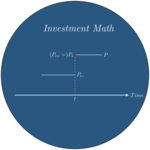Solution of the Exam (2016)
This is the solution of the exam for the 2016 ensae course.
Exercise 1
The program is: \[\underset{\pi}{\text{min}} \; \pi' \Sigma \pi.\] \[\text{s.t.}:\] \[\pi'(\mu-re)=\mu_{p}-r.\] Lagrangian: \[\pi' \Sigma \pi-\gamma_{\mu_{p}-r}\pi'(\mu-re),\] which leads to the system (first order condition, constraint): \[\Sigma \pi=\gamma_{\mu_{p}-r}(\mu-re),\] \[\pi'(\mu-re)=\mu_{p}-r.\] Solution: \[\gamma_{\mu_{p}-r}=\frac{\mu_{p}-r}{(\mu-re)'\Sigma^{-1}(\mu-re)},\] \[\pi_{\mu_{p}-r}=\frac{\mu_{p}-r}{(\mu-re)'\Sigma^{-1}(\mu-re)}\Sigma^{-1}(\mu-re).\] The shape of the efficient frontier is linear.
We must have: \[\mu^{*}-r=\frac{(\mu-re)'\Sigma^{-1}(\mu-re)}{e'\Sigma^{-1}(\mu-re)}.\]
It is the efficient frontier of portfolios invested on risky assets only (no cash).
Adding an asset to the investment universe improves possibilities. The efficient frontier attached to a narrower universe is thus necessarily below that of the full universe. In our case, the risky asset efficient frontier is below the full efficient frontier. Both frontiers meet at \(\pi^{*}\). They are tangent to each other at \(\pi^{*}\).
This follows from the formula for \(\mu^{*}-r\), that of \(\pi_{\mu_{p}-r}\) and that of \(\gamma_{\mu_{p}-r}\).
\(\Sigma\pi_{\mu_{p}-r}\) is a vector where component \(i\) measures the covariance of asset \(i\) with the return of portfolio \(p\). It is by construction the derivative of portfolio with respect to a change in position. Therefore, the marginal change in risk brought up by a change in position \(\pi_{\mu_{p}-r,i}\) is the covariance of the corresponding return with the portfolio return. The first order condition says that at the optimum, these marginal changes in risk must be proportional to the excess returns. Covariances need to be proportional to excess returns. The gradient of the risk function must be orthogonal to the level sets induced by the constraint.
We have: \[\Sigma\pi=\frac{\mu_{p}-r}{\mu^{*}-r}\frac{\mu^{*}-r}{(\mu-re)'\Sigma^{-1}(\mu-re)}(\mu-re),\] and this translates into (using question 5.): \[\Sigma\pi^{*}=\frac{\mu^{*}-r}{(\mu-re)'\Sigma^{-1}(\mu-re)}(\mu-re).\] All first order conditions (i.e. for all excess return targets) boil down to the same one, which is the one of the tangent portfolio. Indeed, all investors apply the same trade-off.
We have: \[\Sigma\pi^{*}=\frac{\mu^{*}-r}{(\mu-re)'\Sigma^{-1}(\mu-re)}(\mu-re),\] and as a result: \[\sigma^{*2}=\pi^{*'}\Sigma\pi^{*}=\frac{\mu^{*}-r}{(\mu-re)'\Sigma^{-1}(\mu-re)}(\mu^{*}-r).\] Combining the two relationships we get: \[\frac{\Sigma\pi^{*}}{\sigma^{2*}}(\mu^{*}-r)=(\mu-r),\] i.e.: \[\beta(\tilde{r}_{i},\tilde{r}^{*})(\mu^{*}-r)=(\mu-r).\] Beta is the coefficient of the regression of \(\tilde{r}_{i}\) on \(\tilde{r}^{*}\). This relationship says that all expected excess returns of the asset are proportional to their beta with the market. In the excess return/beta space, all assets are on a line that goes through the origin.
If all investors share the same beliefs and only differ in their risk aversion parameters (within the above quadratic family of utility functions), they will all hold the tangent portfolio as their risky asset holding (although the proportion invested in the tangent portfolio will be different from one investor to the next). The aggregated risky asset portfolio is equal to the overall market and it must be the tangent portfolio. As a result, the beta relationship holds with the tangent portfolio being replaced by the market portfolio. This is the capm.
Exercise 2
The program is \[\underset{\pi}{\text{min}} \; \pi' \Sigma \pi.\] \[\text{s.t.}:\] \[\pi'e=1.\] Lagrangian: \[\pi' \Sigma \pi-\gamma \pi'e,\] which leads to the system (first order condition, constraint): \[\Sigma \pi=\gamma e,\] \[\pi'e=1\] Solution: \[\gamma=\frac{1}{e'\Sigma^{-1} e},\,\pi^{mv}=\frac{1}{e'\Sigma^{-1} e}\Sigma^{-1}e\,\] \[\pi^{mv}_{i}=\frac{\sigma_{i}^{-2}}{\sum_{i}^{n}\sigma_{i}^{-2}}.\]
The vector of sensitivities has components: \[s^{mv}_{i}=\frac{\sigma_{i}^{-1}}{\sum_{i}^{n}\sigma_{i}^{-2}}.\]
For the profile of sensitivities to be flat, positions have to be proportional to \(1/\sigma_{i}\). The full investment constraint then leads to:\[\pi^{ew}_{i}=\frac{\sigma_{i}^{-1}}{\sum_{i}^{n}\sigma_{i}^{-1}}.\]
Both portfolios are equal when all variances are equal.
We remember (see the previous exercise for instance) that: \[\pi_{\mu_{p}-r}=\frac{\mu_{p}-r}{(\mu-re)'\Sigma^{-1}(\mu-re)}\Sigma^{-1}(\mu-re).\] This vector is proportional to the vector with components \(\sigma_{i}^{-1}\) (use the diagonal structure of the covariance matrix and that of the returns). The sensitivity profile of \(\pi_{\mu_{p}-r}\) is thus constant.
The first order condition is, componentwise: \[\sum_{j\neq i}\rho\sigma_{j}\sigma_{i}\pi_{j}+\sigma_{i}^{2}\pi_{i}=\gamma\lambda\sigma_{i}.\] One can write this as: \[\sum_{j}\rho\sigma_{j}\sigma_{i}\pi_{j}+(1-\rho)\sigma_{i}^{2}\pi_{i}=\gamma\lambda\sigma_{i},\] which leads to (\(\sigma_{i}>0\)): \[\sum_{j}\rho\sigma_{j}\pi_{j}+(1-\rho)\sigma_{i}\pi_{i}=\gamma\lambda,\] since and we can deduce that \(\sigma_{i}\pi_{i}\) is necessarily constant since \(\sum_{j}\rho\sigma_{j}\pi_{j}\) is itself constant. As a result, position \(\pi_{i}\) has to be inversely related to \(\sigma_{i}\). The sensitivity profile is as in 5..
We have: \[\sigma_{p}^{2}(\pi)=\pi'\Sigma\pi,\] and thus: \[\frac{\partial \sigma_{p}}{\partial \pi_{i}}=\frac{1}{\sigma_{p}}(\Sigma\pi)_{i}.\] Since: \[\Sigma\pi=\gamma(\mu-re),\] we have: \[\frac{\partial \sigma_{p}}{\partial \pi_{i}}=\frac{1}{\sigma_{p}}\gamma (\mu_{i}-r).\]
The function \(\sigma_{p}(\pi)\) is homogenous of degree one, and therefore satisfies: \[\sum_{i=1}^{N}\pi_{i}\frac{\partial \sigma_{p}}{\partial \pi_{i}}=\sigma_{p}.\]
In the context of question 6. we have: \[\pi_{i}\propto\frac{1}{\sigma_{i}},\] and thus: \[\pi_{i}\frac{\partial \sigma_{p}}{\partial \pi_{i}}\propto\frac{1}{\sigma_{i}}\frac{1}{\sigma_{p}}\gamma (\mu_{i}-r)\propto\frac{1}{\sigma_{i}} (\mu_{i}-r)=\text{constant}.\] Thus total contributions to risk are equalized.
Mean-variance efficiency with cash naturally leads to diversified portfolios, in the sense of equally weighting sources of risk. Portfolio constraint such as the long only constraint might threaten diversification. This happens because of conflicts between objectives. Equalizing risk contributions looks like a very ad-hoc way of forcing diversification in portfolios.
Exercise 3
The diffusions: \[\frac{dP_{i,t}}{P_{i,t}}=d\log(P_{i,t})+\frac{1}{2}\xi_{i,t}^{2}dt,\] \[\frac{dV_{\pi,t}}{V_{\pi,t}}=d\log(V_{\pi,t})+\frac{1}{2}\xi_{\pi,t}^{2}dt,\] and drifts are: \[r_{i,t}=\gamma_{i,t}+\frac{1}{2}\xi_{i,t}^{2},\] \[r_{\pi,t}=\gamma_{\pi,t}+\frac{1}{2}\xi_{\pi,t}^{2},\]
We have: \[\frac{dV_{\pi,t}}{V_{\pi,t}}=\sum_{i=1}^{N}\pi_{i,t}\frac{dP_{i,t}}{P_{i,t}},\] from which we get: \[d\log(V_{\pi,t})=\sum_{i=1}^{N}\pi_{i,t}d\log(P_{i,t})+\gamma^{*}_{\pi,t},\] with: \[\gamma^{*}_{\pi,t}=\frac{1}{2}\left(\sum_{i=1}^{N}\pi_{i,t}\xi_{i,t}^{2}-\xi_{\pi,t}^{2}\right).\]
Subtract: \[V_{\eta,t}=\sum_{i=1}^{N}\pi_{i,t}V_{\eta,t},\] from the previous equation.
Apply the previous result with \(\eta=\pi\).
On can write: \[\gamma^{*}_{\pi,t}=-\sum_{i=1}^{N}\pi_{i,t}\frac{d(P_{i,t}/V_{\pi,t})}{P_{i,t}/V_{\pi,t}}+\frac{1}{2}\sum_{i=1}^{N}\pi_{i}d[\log(P_{i,.}/V_{\pi,.})]_{t}.\] Now, consider the portfolio return identity: \[\frac{dV_{\pi,t}}{V_{\pi,t}}=\sum_{i=1}^{N}\pi_{i,t}\frac{dP_{i,t}}{P_{i,t}}.\] One can rewrite it against any numeraire. In particular, we can choose \(V_{\pi}\) as the numeraire. It then reads: \[\frac{d(V_{\pi,t}/V_{\pi,t})}{V_{\pi,t}/V_{\pi,t}}=0=\sum_{i=1}^{N}\pi_{i,t}\frac{d(P_{i,t}/V_{\pi,t})}{P_{i,t}/V_{\pi,t}}.\] We thus obtain: \[\gamma^{*}_{\pi,t}=\frac{1}{2}\sum_{i=1}^{N}\pi_{i}d[\log(P_{i,.}/V_{\pi,.})]_{t}\geq 0,\] with strict inequality if any of the \(\log(P_{i,.}/V_{\pi,.})\) is non deterministic.
Apply 3. with \(\eta=\mu\) and then use \(\mu_{i,t}=P_{i,t}/V_{\pi,t}\).
The log function is strictly concave (\(0\leq \lambda \leq 1,\, a>0,\, b>0\)): \[\log(\lambda a+(1-\lambda)b)\ge \lambda\log(a)+(1-\lambda)\log(b),\] with equality if and only if \(a=b\), \(\lambda=0\) or \(\lambda=1\). Taking two vectors \(x\) and \(y\) in the simplex and mixing them using \(\lambda\), and applying the above inequality, we get: \[S(\lambda x+(1-\lambda)y)\geq \lambda S(x)+(1-\lambda)S(y),\] i.e. \(S(\cdot)\) is (strictly) concave. The first order condition characterizes the maximum of a concave function. One can verify that the gradient of \(S(\cdot)\) is zero for \(x=(1/N,\ldots,1/N)\). Limiting behavior towards the edges of the simplex is trivial.
Under the assumption of the question, relative performance of \(\pi\) versus the market portfolio is driven by changes in \(S\). Starting from \(x=(1/N,\ldots,1/N)\), \(S\) can only decrease, so that portfolio \(\pi\) cannot beat the market portfolio.
We have: \[\log(V_{\pi,t}/V_{\mu,t})-\log(V_{\pi,t}/V_{\mu,t})=S(\mu_{t})-S(\mu_{0})+\int_{0}^{t}\gamma^{*}_{\pi,u}du,\] so that: \[\log(V_{\pi,t}/V_{\mu,t})-\log(V_{\pi,t}/V_{\mu,t})\geq B-\text{max}(S)+\varepsilon t.\] Since the function \(S(\cdot)\) is bounded above, we can conclude that portfolio \(\pi\) will end up beating the market portfolio after a sufficiently long time: \[t\geq \frac{\text{max}-B}{\varepsilon}.\]
